MSR Dragontail Tent
Test
Series by Jamie Lawrence
Long-Term
Report
30th
May,
2008
CLICK
HERE TO SKIP TO THE FIELD REPORT
CLICK HERE TO SKIP TO THE LONG-TERM REPORT
Tester
Information
I
was introduced to
bushwalking/tramping/hiking as a young child in Boy Scouts and through
my
school physical/adventure education. After leaving school, I mainly did
short daywalks until
recently when I have started to again
re-walk some of Tasmania's
key hiking routes and try walks I have yet to attempt. I mainly walk in
the
winter months, in Tasmania's
central highlands areas. I prefer light gear, extended walks (3-5 days)
in a
group of 3 or shorter walks (1-3 days) walking solo. I would generally
carry a
base weight pack of around 8 kg-10 kg (17 lb-22 lb).
Initial Report
6th
February, 2008
Product
Information &
Specifications
|
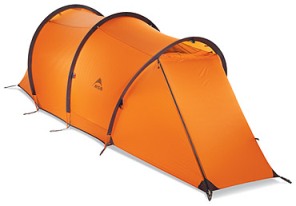
|
|
MSR Dragontail
(Image courtesy MSR)
|
Manufacturer:
MSR
Year of Manufacture: 2008
Manufacturer's Website: MSR
Website
MSRP: US$449.95
Listed Weight: 2.42 kg (5 lbs 5 oz)
Measured Weight: 2.24 kg (5 lbs)
Breakdown of measured component weights
Tent: 1.5 kg (3 lbs 5 oz)
Pegs: 200 g (6 oz)
Poles: 525 g (1 lb 3 oz)
Stuff sacks and accessories: 50 g (2 oz)
Product
Description
|
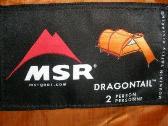
|
|
Dragontail
Label
|
The
Dragontail is a new release
in MSR's Expedition range of tents. This model is a single-walled, 3
pole hoop designed non
free standing shelter with a single entry
at the front with a large front vestibule. It has a 2 person capacity
plus
gear.
A key design feature of this tent is MSR's 'flow through ventilation'
which is
to allow air movement to prevent condensation. This feature consists of
2 flaps
at each end of the tent that can be opened or closed to allow air to
flow through
the top of the tent into a sectioned off mesh 'roof'. The flaps can be
accessed
from inside the tent through zippers in the mess roof and are held in
place by
a series of plastic toggles. The flaps also have a metal hoop to give
them
strength and hold them tight against the body of the tent.
The other features of this tent are MSR's Groundhog II pegs (stakes)
and 3 DAC
NSL Featherlight Aluminum
poles. There is a single, and large, front vestibule which has a single
large
waterproof zipper on the side. Like most other MSR tents, it is a
bright orange
colour and has a dark red floor. There are also large MSR logos on the
side
walls of the tent. This is identical to the other MSR shelter that I
own, the
MSR Hubba Hubba.
Trying
it Out
As
soon as I opened the box and
took out the Dragontail, I knew I was going to like this tent. I was
immediately happy to find that the tent has a bag rather then a stuff
sack as
this is a design I prefer. The bag also has a couple of compression
straps which
again is handy.
|
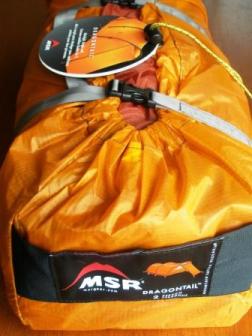
|
|
Packed in Bag
|
Once
I removed the tent from the
bag I discovered the instructions for setup, which are sewn into the
bag on a
large flap that doubles as a closure for the bag. The instructions are
nice and
clear with good diagrams. As this is the first single walled tent that
I have
used, I decided to read the instructions to be sure I was on the right
track.
As I expected, peg out the corners, insert the poles and then peg out
the
remainder of the tent body. It took me around 10 minutes to assemble
all the
poles, feed them into the sleeves and erect the tent. A further 5
minutes of
playing around and the tent was stable and ready to use.
I had no troubles getting the poles into the sleeves, but I was aware
of the
tent body bunching so had to ensure that I had a good spread of the
sleeve over
the poles before bending into the hoop and clipping into the eyelets at
the
base of the tent. I was setting the tent up on very hard ground and
found it
was impossible for me to push the Groundhogs all the way into the
ground. As
there was a light breeze blowing, I found that the tent lifted off the
pegs a
few times. This I noted for future reference as I may need to carry
some
smaller pegs depending on where I intend to camp. I did not bother with
the guy
ropes as I did not need them and only had the tent set up for 15
minutes.
This tent is big, very big. There is ample room for 2 people, with
heaps of
head room and enough space to avoid touching the walls of the tent I
suspect.
The front vestibule is massive, I could easily out a couple of packs
and boots
in there as well as a bunch of cook gear and still have space to enter
and
exit.
Testing
Strategy
I
will look to test the MSR
Dragontail over the coming months as we enter our Southern Hemisphere
autumn
(fall) and early winter. Over these months I have several trips planned
that will
expose the Dragontail to varied
and I expect difficult
conditions. As MSR state on their website 'The Dragontail is the
epitome of ultralight,
single-wall protection for extreme conditions.'
I hope this is the case and am
looking forward to
finding out.
Field Report
20th
March, 2008
Field
Locations &
Conditions
I
have used the Dragontail on 2
recent trips. The first was an overnight trip to Cockle Creek, in far
southern Tasmania.
Here we camped by a river, not far
from the beach at 13 m (42 ft) above sea level. The temperature ranged
from a
low of 7 C (44 F) to 26 C (79 F). There was no rain.
The second trip was on a 4-day circuit of Tasmania's
central highland lakes. Over this
trip 3 nights were spent camped at elevations between 958 m (3,143ft)
and 1,104
m (3,622 ft) above sea level. I was not able to take temperature
readings at
each camp site but the nearby weather station recorded a low of 3 C (37
F) and
a maximum of 21 C (70 F) during the trip. Over this period around 13.2
mm (0.5
in) of rain fell. There were no periods of any decent wind.
|

|
|
Lake
Challice -
Tasmanian Highlands
|
Performance
in the Field
So
far I have been both very impressed
and somewhat disappointed with the Dragontail.
|
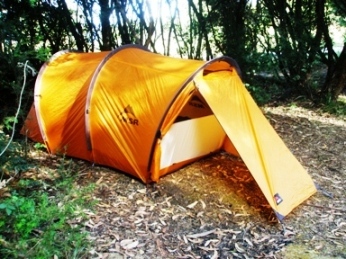
|
|
Cockle Creek Campsite
|
I really do like this tent,
it is light, relatively
compact, very well built and has massive amounts of space inside. I
have found
there to be no real problems setting the tent up, as I have now done it
a
couple of times. I have found that contrary to the instructions
provided by
MSR, it is much easier to insert the poles before pegging the tent out.
I've
found it easier to insert all the poles then clip the 2 end poles in
place,
then the centre pole. I find it is very hard to get the poles to clip
into
place whilst the tent is pegged out as there is too much tension.
However I do
have to remember when feeding each pole into the sleeve to ensure the
tent
fabric is evenly spread across the pole otherwise it is very hard to
erect the
tent when it is bunched.
|
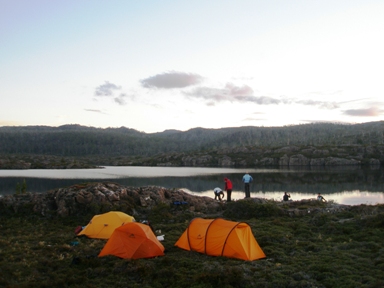
|
|
Camp at Lake
Challice
|
The main feature I like is the amount of room this tent provides. On
both of
the above trips I was with my fiancée and both of us are
around 1.7 m (5 ft 7 in)
in height. With 2 sleeping mats and sleeping bags we still have ample
room
between us and the walls of the tent. I have also found that the quite
steep
walls of the tent and high roof make the internal space seem very
large. We can
both change clothes,
adjust our sleeping gear and
generally use the tent at the same time and have plenty of room. We can
store
two large (70 L/4,227 cu in) packs plus boots plus some cook gear in
the front
vestibule without restricting our access to the internal door. We have
actually
slept in the tent with our heads facing both the door and the rear of
the tent
and found very little difference between the two positions. The picture
to the
right shows the Dragontail set up next to my MSR Hubba
Hubba. The Dragontail is
clearly a much larger tent.
A central feature of this tent is the "flow-through" vent that runs
the length of the tent. On all occasions of using the Dragontail I have
had
both the end vents open. As an additional bonus I have found that
looking
through the mesh ceiling through the open vents makes them very handy
as
windows. I can see very clearly what is happening outside without
needing to
get wet. I tested this when I was woken up by a brief period of heavy
rain and
I could not remember if I had left any gear outside. I simply popped my
head up
and could see quite clearly around, and also get a good look at the
oncoming
weather! The internal zippers make access to the vent doors very easy.
|
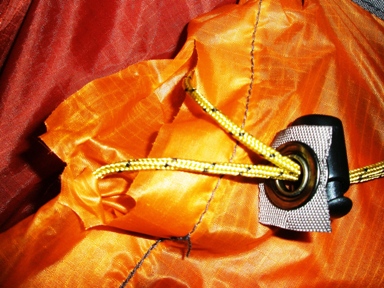
|
|
Torn Bag
|
I have also been surprised by the Groundhog stakes (pegs). As these
have no
curved top on them, I was concerned the tent would come away from the
pegs but this
has never happened. I have found that I can not push the pegs into the
ground
with my hands as the tops are just too sharp and hurt my palms. The
pegs have
handy rope loops on top which make removing them from the ground very
easy.
When I had the Dragontail set up in alpine grass, I found these ropes
were
critical as I had trouble finding the tops of the pegs. I was most
pleased to
recently receive from MSR the optional footprint for the Dragontail.
This has
made a difference both in terms of warmth and durability as I was
concerned
that the floor was very thin. The only drama this has now presented is
I do not
have enough Groundhog stakes to cover both the tent and the footprint
as I seem
to find that the footprint doesn't perfectly align with the tent floor
thus the
peg loops do not meet. This may be my error so I will continue to
monitor this
in future testing.
|
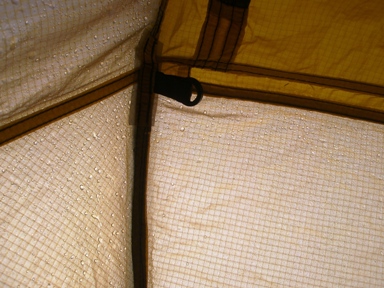
|
|
Condensation
|
On
the downside, I have been
disappointed with the amount of condensation I have experienced using
the
Dragontail. As this is my first time using a single-walled tent, I did
not have
an expectation of how much condensation I would get, but I expected I
would get
some. On the first trip to Cockle Creek I was happy to awake to a dry
tent.
However this did not hold true when using the tent on the most recent
trip.
Each morning I awoke to very wet tent walls. In one case I had to hang
the tent
in the sun from the roof of a hut as the tent was too wet to pack away.
This
remained an issue and forced me to make sure I had the tent set up and
dried
when I arrived at my next camp spot prior to laying out my sleeping
gear to
prevent it getting wet.
Whilst condensation has been the only major issue that I have had with
the
Dragontail, I have had a couple of other little annoyances. Firstly,
when I
packed up the tent after Cockle Creek, the draw string tore the bag as
the
metal eyelet pulled away from the bag. I now can not use the drawstring
to
completely compress the tent when it is stowed in the bag as this may
cause the
tear to get larger.
I have also found that the toggles that hold the external and internal
doors in
place are a touch too short as I have to really pull them into the
plastic
loops. I have also found the internal mesh pockets, whilst long, are
too
shallow to be of much use, particularly when I am having issues with
condensation. I have found that the items simply get wet.
Summary
Overall,
I had very big
expectations for the Dragontail. I had only used a double-walled tent
in the
past so I was disappointed with the amount of condensation that I
experienced
with the single-walled design so far.
Whilst condensation has been a problem, this is a great tent and I find
it far
more liveable and warmer then my double-walled. When it rained I was
very dry
inside, and was surprised at how little water got through the
"flow-through" vent doors.
Testing
Strategy
As
my testing continues, I will
start to move into the late southern hemisphere autumn (fall) and early
winter.
For me in Tasmania
this means rain, wind, snow and generally much harder conditions then I
have
experienced since commencing this test series.
I look forward to seeing if my issues with condensation ease as the
temperatures start to drop and humidity is reduced.
Long-Term Report
30th
May, 2008
Long-Term
Testing Locations
& Conditions
|
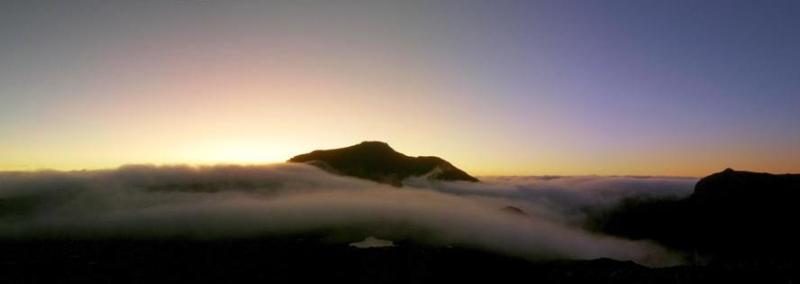
|
|
Mt Field West from K Col
|
I have continued
my testing of the MSR Dragontail by getting into the mountains. I
recently
completed a 2 night walk in the Mt Field National Park. The first night
was
spent at Lake
Dobson
at 1,047 m (3,453 ft). This night was a rather wet and windy night.
Around
7.2mm (0.28in) of rain fell with a night low temp recorded of 4.2 C
(39.5 F).
Although I wasn't able to measure wind speeds, gusts were recorded at a
nearby
weather station of 24 km/h (15 mp/h).
The second night
of this walk was spent camped at K Col,
around 1,210 m (3,970 ft) above sea level. I was not able to record
temperatures at this camp, however I am sure it was below freezing (0
C/ 32 F)
as when I awoke I found the ground and nearby small tarn frozen. There
was no
rain or snowfall but it was very foggy and misty.
Performance
in the Field
As
outlined in my Field Report, I
was having problems with condensation in this tent and was keen to see
if
cooler temperatures would ease this problem. I certainly was able to
test this
tent in freezing conditions however I was the only occupant in the MSR
Dragontail on this last trip. I did notice a reduced amount of
condensation
which was pleasing, however I suspect this may have been due to the
fact that
there was one less person in the tent.
I am not 100% convinced that the flow through vent system is totally
effective
in minimising condensation. I've found the worst condensation occurs on
the vestible fly, just
near the internal door as well as the
top corners of the tent. This is strange as these points are the
closest to the
vent doors! On a positive, the vents do make for wonderful view points
out of
the tent, especially through the mesh ceiling. I've found this quite
handy in
bad weather to check what is happening outside. I've found that I have
had no
issues with rain entering through the vents, especially when they are
open to
improve ventilation, which is nearly always as the tent can be very
stuffy. The
internal zippers make accessing and thus opening or closing the vent
doors from
inside the tent very easy. Generally I think that if this single skin
design
was constructed out of a more breathable fabric then this may be more
effective
in reducing condensation.
|
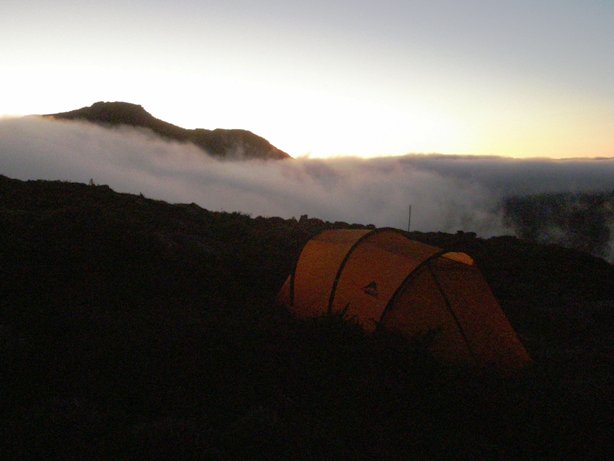
|
|
Camp at K Col, Mt Field
NP
|
Until
the trip to Mt Field I had
not had the Dragontail exposed to windy conditions. As previously
mentioned, I was
camped at K Col on the second night of this trip which is very open and
exposed. I was not able to measure the wind gusts, but the wind was
strong
enough for me to need to guy the tent out with the supplied guy ropes.
I found
the easiest way to do this was simply tie them to one of the various
loops on
the tent around the poles and then peg out with one of the Groundhog
stakes.
The Dragontail is supplied with 2 lengths of guy rope (which is
reflective) and
2 tensioners. These are
a Z-shaped piece of plastic
and I could not for the life of me figure out how to use them! After
having a
quick play around, I simply tied a loop in the end of the guy rope and
hooked
this around the Groundhog stake. Whilst this had the desired effect of
adding
some more resistance to the wind, it did also mean I had 2 long lengths
of rope
to contend with when moving around the tent. Not a major drama as they
are
reflective which means I was able to see them very clearly with my
headlamp.
I have found that since I received the addition of the MSR ground sheet
for the
Dragontail I feel a lot more confident pitching it on rough or uneven
ground.
The ground that I pitched on in Mt Field was mainly alpine grass with
rock and
shrubs. I had no problems with any sharp branches or rock punching
through the
floor and found that I had no issues with moisture coming through the
floor as
the ground thawed in the morning. I have continued to find that this
ground
sheet is still not quite the right size, seemingly too short at the
door end of
the tent.
I have continued to use my preferred set-up technique rather then the
instructions supplied by MSR as I find this much easier. With the
addition of
the ground sheet I stake out the four corners and then insert the poles
into
the sleeves. I then attach the non door end to the stakes holding down
the
ground sheet. Once these are in place, I simply pull the corners near
the
internal door tight and stake out and the tent then pops up into the
tunnel
shape. If I need to stake down further sections or attach guy lines
then I do
so for extra strength. During the poor weather I experienced at Mt
Field I had
no problems with the tent feeling unstable or insecure by using this
set-up.
Summary
Overall,
I have enjoyed many
aspects of the MSR Dragontail over the test period. The main feature is
the
room, especially the head room. The high vertical walls of this tent
produce
loads of internal space, easily able to accommodate 2 people plus gear.
If I
were forced to spend long periods of time in this tent due to bad
weather, this
would certainly help make it more bearable. I have been impressed with
the
strength to resist wind and the general protection this tent offers
from the
elements. During periods of rain I have seen no evidence of water
looking
likely to enter and I have certainly felt warm and secure inside during
windy
conditions. I find the tent is easy to set-up and can be done easily
with one
person in easy weather conditions. I have also found that the wide
opening on
the top of the storage bag for this tent makes it quick and easy to
pack away
and I can compress it quite well with the compression straps to reduce
the
size. Whilst this is a big shelter for one person, the weight is
certainly
lower then my other 4 season MSR tent which makes it preferred if I am wanting to lower my pack
weight.
As a trade off I have to be prepared to accept the chance of
condensation and a
possible delay in getting away in the morning whilst I wait for the
tent to dry
to aviod a wet tent at
night. I have also found that
the side internal pockets are too low, meaning things that I would
normally
stash in there such as a water bottle or camera
either fall out or
they get wet from condensation. If I was 100% confident that
condensation was
not going to be an issue, this would easily become my preferred 4
season
shelter.
This concludes my test series for the MSR Dragontail tent. I have
greatly
appreciated the opportunity to test this excellent product and I thank
MSR Corp
and BackpackGearTest.org




